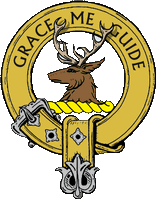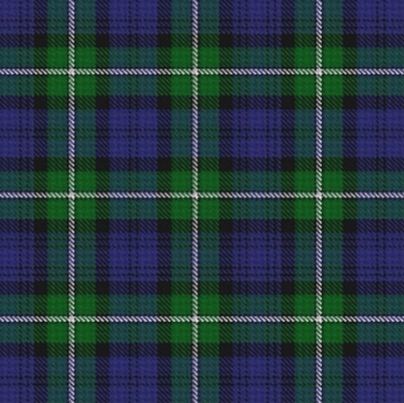CREST: A stag's head, attired with ten tynes, proper
MOTTO: Grace Me Guide
SEPTS: Bannerman, Berrie, Berry, Boyce, Boyes, Lumsden, Macouat, Macowatt, MacQuattie, MacWatt, Mechie, Mekie, Meldrum, Michie, Middleton, Walter, Walters, Watson, Watt, Watters, Wattie, and Watts
Forbes is an ancient Scottish family in the district of Mar in Aberdeenshire, in the north-east of Scotland. In ancient times, this was Pictland, the land of the Picts. In the 6th and 7th centuries, Gaelic invaders from northern Ireland (called "Scoti" by the Romans) created the overkingdom of Dál Riata (also called Dalriada) in the islands and highlands of Scotland. Dalriadic warriors pushed eastward into Pictland and intermarried with the Picts. According to legend, around 775 A.D., the Dalriadic warrior O’Conchar Forbhasach II killed a bear at the Nine Maidens’ Well at Logie, in the parish of Auchindore. For this valiant achievement, he won the “duthchas” (the Gaelic word for domain by right) for a substantial estate in Aberdeenshire. His descendants later intermarried with the Pictish people. This is the reason for the three muzzled bear heads on the coat of arms for Lord Forbes.The first recorded Chief is Duncan de Forbes, who received a charter of the Barony of Forbes from King Alexander III of Scotland in 1272. Duncan built the first Castle Forbes at Druminnor. The title Lord Forbes was created 600 years ago, around 1430, for Sir Alexander de Forbes. Lord Forbes has been the premier Lord of Parliament in the Peerage of Scotland since 1633. Today, the Chief of the House of Forbes is Malcolm, 23rd Lord Forbes. He is seated at Castle Forbes (formerly Putachie), near Alford in Aberdeenshire. Over the centuries, over 100 branches of the House of Forbes descended from the main line of the Lords Forbes, including Pitsligo, Tolquhon, Culloden, Craigievar, Corse, Newe, Granard (Ireland), and De Forbin (Sweden.) The First Forbes in America was John Forbes (or Fobes) of the branch Forbes of Corse who emigrated to the Plymouth Colony in 1629. Many Forbeses emigrated to the Cape Fear area in North Carolina, USA, as a direct result of the Jacobite uprisings between 1689 to 1745. Many loyalist Forbeses fled to Canada after the conclusion of the American Revolutionary War in 1783.
For a printable pdf with more information, click
HERE

